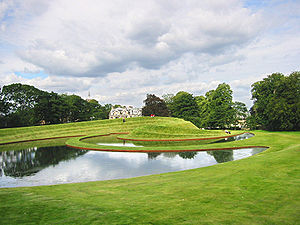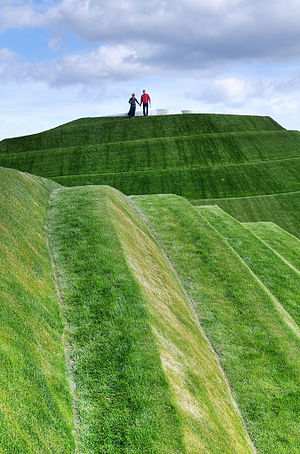- Charles Jencks
-
Charles Alexander Jencks (born 21 June 1939) is an American architectural theorist, landscape architect and designer. His books on the history and criticism of Modernism and Postmodernism were widely read in architectural circles and beyond. Born in Baltimore to a Scottish mother from Fife,[1] he first studied English Literature at Harvard University, later gaining an MA in architecture from the Graduate School of Design in 1965. He also has a PhD in Architectural History from the Bartlett School of Architecture at University College, London. In the mid-sixties Jencks moved to Scotland where he has lived ever since.[1]
Contents
Early Years
Jencks studied under the Modern architectural historians Siegfried Giedion and Reyner Banham. He first received his BA in English Literature at Harvard University in 1961, later gaining an MA in architecture from the Graduate School of Design in 1965. He took his studies even further and received his PhD in Architectural History from University College, London in 1970. In the mid-sixties Jencks moved to Scotland where he lived with his late wife Maggie Keswick Jencks. He now designs landscape sculpture and writes on cosmogenic art.
Landscape Architecture
The Garden of Cosmic Speculation, begun in 1988, was dedicated to Jencks' late wife Maggie Keswick. The garden has such a name because Jencks, Keswick, scientists, and their friends designed the garden based on natural and scientific processes. Jencks goal was to celebrate nature, but he also incorporated elements from the modern sciences into the design. The garden contains a species of plants that are pleasurable to the eye, as well as edible. With a ‘century of extraordinary discovery in biology’ like evolution and deoxyribonucleic acid also known as DNA, and cosmology, this has given birth to a new type of garden design [Cosmic]’. Preserving paths and the beauty of the garden is still evident in the garden except, Jencks enhances the garden using new tools and artificial materials. Just as Japanese Zen gardens, Persian paradise gardens, the English and French Renaissance gardens were analogies of the cosmic universe, the design of the garden represents the cosmic and cultural evolution of the contemporary world. The garden represents a microcosm of the universe. As one walks through the garden they are experiencing the cosmic universe in miniature. According to Jencks gardens are like autobiographies because they reveal the happiest moments, the tragedies, and the truths about a person. As the garden developed since 1988, so too did such sciences as cosmology and this allow a dynamic interaction between the unfolding universe, a progressing science and a question design. Jencks believes that contemporary science is potentially the greatest moving force for creativity of our time because it tells us the truth about the way the universe is. Cosmic passion, the desire both to know and to relate to the universe, is one of the strongest drives in sentient creatures on a par with those which exercise novelists: sex, money, and power. Every creature in the universe tries to increase its knowledge, to figure out what is going on, what will happen next, how things are evolving and the point of this passion how we can relate to this process, fit in with its patterns, celebrate and on occasion, criticize it. The laws of nature may be omnipotent, but they can also be challenged. A garden is a perfect place to try out these speculations and celebrations because it is a bit of man-made nature, a fabricated and ideal cosmic landscape, and a critique of the way the universe is.
Jencks has become a leading figure in British landscape architecture. His landscape work is inspired by fractals, genetics, chaos theory, waves and solitons. In Edinburgh, Scotland, he designed the Landform at the Scottish National Gallery of Modern Art in collaboration with Terry Farrell and Duncan Whatmore of Terry Farrell and Partners. These themes are expanded in his own private garden, the Garden of Cosmic Speculation, at Portrack House near Dumfries. He is also a furniture designer and sculptor, completing the DNA Sculpture in London's Kew Gardens in 2003.
His late wife, Maggie Keswick Jencks, was the founder of Maggie's cancer caring centres, for which Jencks has designed gardens, and the author of a book on Chinese Gardens.
Architectural Writing
Jencks is synonymous with his writings of Postmodernism in architecture. He discusses his theories of postmodern architecture in his book the Language of Post-Modern Architecture. Jencks discusses the paradigm shift in modern to post-modern architecture. Modern architecture concentrates on univalent forms such as right angles and square buildings often resembling office buildings. However, post modern architecture focuses on forms derived from the mind, body, and nature. His latest book the Iconic Building examines the trend setting and celebrity culture. Jencks discusses why buildings are being designed this way. The reason that our culture seeks the ‘iconic building’ is because it has the possibility of reversing the economic trend of a flagging “conurbation”. An iconic building is created to make a splash, to generate money, and the normal criteria of valuation does not apply. “Enigmatic signifiers” can be used in an effective way to support the deeper meaning of the building. Jencks has lectured at over forty universities throughout the globe, including Peking, Shanghai, Tokyo, Milan, Barcelona, and in the US at Harvard, Columbia, Princeton, and Yale. In his most recent work he collaborated with the late Maggie Keswick on fractal designs of building and furniture as well as extensive landscape designs base on complexity theory, waves and solitons.
Critical Modernism - Where is Post Modernism going?
Critical Modernism - Where is Post Modernism going is the latest book by Charles Jencks. It is an overview of post-modernism in which Jencks argues that Post modernism is another critical reaction to Modernism that comes from within Modernism itself.[2][3][4]
On 26 March 2007, the Royal Academy hosted a debate between Jencks and John N. Gray centered around the book.[5]
Other Works
- Symbolic Furniture, exhibition Aram Designs London 1985.
- Garagia Rotunda, Truro, MA 1976-77.
- The Elemental House (with Buzz Yudell), Los Angeles.
- The Thematic House (with Terry Farrell), London, 1979-84.
- Landform in Edinburgh for The Scottish Gallery of Modern Art.
- Matt Ridley, Center for Life, Newcastle, May 2000.
- Designs for Black Hole Landscape, IUCAA, Pune, India, 2002.
Television
Has appeared on television programmes in the US and UK, written two feature films for the BBC (on Le Corbusier and on Frank Lloyd Wright and Michael Graves).
- Kings of Infinite Space, 1983;
- Symbolic Architecture, 1985;
- Space on Earth, 1986;
- Battle of Paternoster Square, 1987;
- Pride of Place, 1988;
- A Second Chance, 1989;
- Let the People Choose, 1990. BBC Late show:
- New Moderns, 1990;
- La Villette, 1991;
- Tokyo, 1991 (1992 BP Arts Journalism TV Award);
- Libeskind, Jewish Museum, Berlin, 1991;
- Culture Debate, 1991;
- Frank Gehry and Los Angeles, 1992;
- Philip Johnson, The Godfather 1994.
- BBC: Gardens of the Mind. Television programme and conference organised around work-in-progress, New World View, Tokyo and Kyoto, May 1991.
- TV Film: 50 minutes "The Garden of Cosmic Speculation" 1998.
- Richard Meier The Frame; Daniel Libeskind; The Spiral, 1999.
- Appearances in film: Rebuilding the Palace; Frank Lloyd Wright - Tin Gods, 2002.
- Recreating Eden, Part 2, BBC for Gardens Through The Ages - 200
Select bibliography
- The Architecture of Hope - Maggie's Cancer Caring Centres, Frances Lincoln, London, 2010.
- Critical Modernism - Where is Post Modernism going?, Wiley Academy, London, 2007.
- The Iconic Building - The Power of Enigma, Frances Lincoln, London, 2005.
- The Garden of Cosmic Speculation, Frances Lincoln Limited, London, October 2003.
- The New Paradigm in Architecture, (seventh edition of The Language of Post-Modern Architecture), Yale University Press, London, New Haven, 2002.
- Le Corbusier and the Continual Revolution in Architecture, The Monacelli Press, 2000
- Architecture 2000 and Beyond, (Critique & new predictions for 1971 book), Academy, Wiley, May 2000
- The Architecture of the Jumping Universe, Academy, London & NY, 1995. Second Edition Wiley, 1997.
- Heteropolis - Los Angeles, The Riots & Hetero-Architecture, Academy, London & NY, 1993.
- The New Moderns, Academy London, Rizzoli, NY 1990.
- The Prince, The Architects and New Wave Monarchy, Academy, London and Rizzoli, NY 1988.
- Post-Modernism, The New Classicism in Art and Architecture, Rizzoli, NY and Academy, London 1987; German edition, 1987, reprinted 1988.
- What is Post-Modernism?, St Martins Press, NY 1986, Academy, London 1986. Second Edition 1988. Third Edition 1989. Fourth Edition 1996.
- Towards A Symbolic Architecture, Rizzoli, NY; Academy, London 1985.
- Kings of Infinite Space, St. Martins Press, NY; Academy, London 1983.
- Abstract Representation, St. Martins Press, NY 1983, Architectural Design monograph, London 1983.
- Skyscrapers - Skycities, Rizzoli, NY 1980, Academy, London 1980.
- Signs, Symbols and Architecture, edited with Richard Bunt and Geoffrey Broadbent, John Wiley, NY and London 1980.
- Late-Modern Architecture, Rizzoli, NY 1980, Academy, London 1980. Translated into German and Spanish.
- Bizarre Architecture, Rizzoli, NY 1979 and Academy, London 1979.
- The Language of Post-Modern Architecture, Rizzoli, NY 1977, revised 1978, Third Ed. 1980, Fourth Ed. 1984, Fifth Ed. 1988, Sixth Ed. 1991, Academy Editions London 1977, 1978, 1980, 1984, 1991.
- Modern Movements in Architecture, Anchor Press, NY 1973.
- Adhocism, with Nathan Silver, Doubleday, NY 1972.
References
- ^ a b Sweeney, Charlene (November 6, 2009). "Charles Jencks's Fife Earth Project gets go-ahead". The Times (London). http://www.timesonline.co.uk/tol/news/uk/scotland/article6904970.ece. Retrieved March 4, 2010.
- ^ Wiley, Publisher
- ^ Amazon Books
- ^ TVO, Big Ideas Talk: Charles Jencks
- ^ "RA Forum Debate with Charles Jencks: Critical Modernism". http://www.royalacademy.org.uk/events/focusdays/ra-forum-debate-with-charles-jencks-critical-modernism,193,EV.html. Retrieved March 4, 2010.
- "Cv." Index. Web. 01 Dec. 2010. <http://www.charlesjencks.com/cv.html>.
- "Charles Jencks, Esq." Web. 29 Jul. 2011. <http://www.debretts.com/people/biographies/browse/j/16095/Charles%20Alexander+JENCKS.aspx>.
- "Designs." Index. Web. 01 Dec. 2010. <http://www.charlesjencks.com/designs.html>.
- Jencks, Charles. Modern Movements in Architecture. Harmondsworth: Penguin, 1973. Print.Jencks, Charles. Post-modern Classicism: the New Synthesis. London: Architectural *Design, 1980. Print.
- Jencks, Charles. The New Paradigm in Architecture: the Language of Post-modernism. NewHaven, CT: Yale UP, 2002. Print.
- Jencks, Charles. The Garden of Cosmic Speculation. London: Frances Lincoln, 2005. Print.
- Jencks, Charles. The Iconic Building. New York, NY: Rizzoli, 2005. Print.
- Jencks, Charles. The Post-modern Reader. London: Academy Editions, 1992. Print.
External links
Categories:- 1939 births
- Living people
- Harvard University alumni
- American architecture writers
- American architectural historians
- American landscape architects
- Architectural theoreticians
Wikimedia Foundation. 2010.


